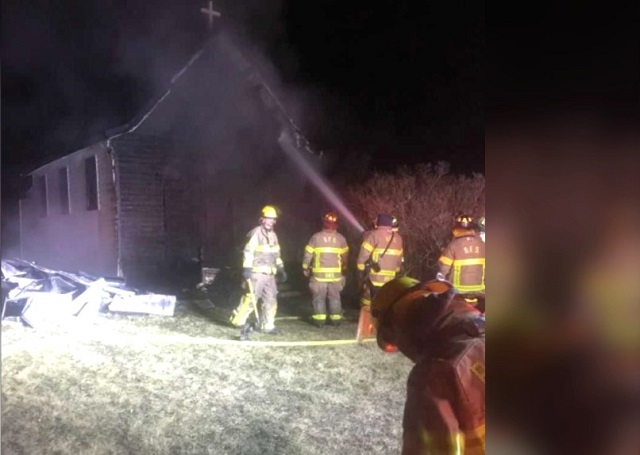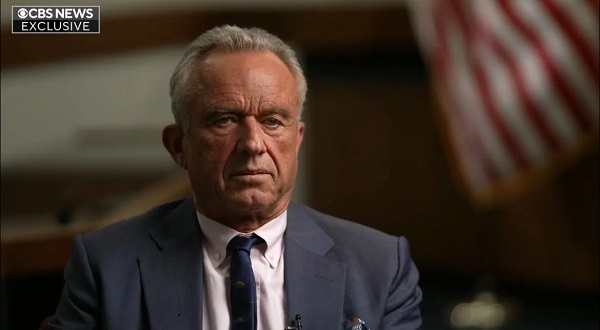Alberta
Two more historic churches in Canada set ablaze by arsonists

From LifeSiteNews
“These are absolutely despicable attacks on the Christian community”
Two historic Christian churches in Canada were intentionally set on fire late last week in what police said were suspected acts of arson.
The incident has Conservative political leaders calling for an end to “attacks” on Christianity after more than 100 churches having been targeted with arson or vandalism since 2021.
The Royal Canadian Mounted Police (RCMP) say St. Aidan’s Church, known as Glenreagh Church, and Pioneer Church, a United Church, both located in Barrhead, a town 120 miles northwest of Alberta’s capital Edmonton, were destroyed by arson within only two hours of each other on the evening of December 7.
No one was reported to have been hurt in the fires, but both churches have been extensively damaged, likely beyond repair, despite the best efforts of the Barrhead Fire Services, which was onsite quickly.
Barrhead RCMP confirmed that an initial investigation has determined that both fires were intentionally set. However, an exact motive is not yet clear.
According to eyewitnesses on the ground, two older pickup trucks were seen fleeing the scene.
An initial investigation by fire examiners confirmed that both fires were deliberately set.
Local resident Edith Strawson, whose dad helped build St. Aidan’s Church over 100 years ago, and who got married in the church, as well as some of her kids, said, “We’re putting this back together.”
“We just can’t let that happen and just leave it,” she said as per a CTV report.
Attacks on Christianity ‘must’ stop say conservative leaders
Leader of the Conservative Party of Canada (CPC) Pierre Poilievre condemned the attacks.
“These are absolutely despicable attacks on the Christian community,” Poilievre wrote Friday on X (formerly Twitter).
“Police must find and arrest the criminals responsible for setting fire to these two churches.”
These are absolutely despicable attacks on the Christian community.
Police must find and arrest the criminals responsible for setting fire to these two churches. https://t.co/ZKUHpaLrzu pic.twitter.com/c7Xxn8qMjb
— Pierre Poilievre (@PierrePoilievre) December 8, 2023
Alberta Premier Danielle Smith, the leader of the United Conservative Party, said church burnings have “no place in Alberta” and those who destroyed the churches by arson need to stand for their “crimes.”
She also confirmed that the RCMP is investigating the church fires “as suspected cases of arson.”
“Images like these have no place in Alberta,” Smith wrote Friday on X (formerly Twitter).
“To the parishioners of these churches and to the Christian community across our province, I stand in solidarity with you against all forms of hate.”
Images like these have no place in Alberta.
RCMP are investigating two churches which were destroyed by fires as suspected cases of arson.
To the parishioners of these churches and to the Christian community across our province, I stand in solidarity with you against all… pic.twitter.com/KmdQ3vc98S
— Danielle Smith (@ABDanielleSmith) December 8, 2023
Smith said that the church burnings “are condemned in the strongest possible terms and those perpetrating these crimes must be brought to justice.”
“I am closely monitoring this unfolding situation along with Minister of Public Safety and Emergency Services Mike Ellis,” she added.
Since the spring of 2021, well over 100 churches, most of them Catholic, but all Christian have either been burned or vandalized across Canada. The attacks on the churches came shortly after the unconfirmed discovery of “unmarked graves” at now-closed residential schools once run by the Church in parts of the country.
In 2021 and 2022, the mainstream media ran with inflammatory and dubious claims that hundreds of children were buried and disregarded by Catholic priests and nuns who ran some of the schools.
Despite the church burnings, the federal government under Prime Minister Justin Trudeau has done nothing substantial to bring those responsible to justice, nor to stem the root cause of the burnings.
Instead, a little over a month ago, Liberal and NDP Members of Parliament (MPs) struck down a Conservative Party of Canada motion that would have condemned incidents of church burnings and acts of vandalism.
In August of 2022, LifeSiteNews reported about the destruction by fire of one of the oldest standing Catholic churches in Alberta. Police at the time said the fire was a “suspicious” incident.
Despite the massive number of church fires in Canada, Canadian Heritage Minister Pablo Rodriguez in May made a brazen suggestion recently that the recent slew of anti-Christian church burnings in Canada could be remedied through further “online” internet regulation.
Those with any information on the church fires are asked to contact Barrhead RCMP at 403-780-674-4848.
Alberta
Alberta takes big step towards shorter wait times and higher quality health care

From the Fraser Institute
On Monday, the Smith government announced that beginning next year it will change the way it funds surgeries in Alberta. This is a big step towards unlocking the ability of Alberta’s health-care system to provide more, better and faster services for the same or possibly fewer dollars.
To understand the significance of this change, you must understand the consequences of the current (and outdated) approach.
Currently, the Alberta government pays a lump sum of money to hospitals each year. Consequently, hospitals perceive patients as a drain on their budgets. From the hospital’s perspective, there’s little financial incentive to serve more patients, operate more efficiently and provide superior quality services.
Consider what would happen if your local grocery store received a giant bag of money each year to feed people. The number of items would quickly decline to whatever was most convenient for the store to provide. (Have a favourite cereal? Too bad.) Store hours would become less convenient for customers, alongside a general decline in overall service. This type of grocery store, like an Alberta hospital, is actually financially better off (that is, it saves money) if you go elsewhere.
The Smith government plans to flip this entire system on its head, to the benefit of patients and taxpayers. Instead of handing out bags of money each year to providers, the new system—known as “activity-based funding”—will pay health-care providers for each patient they treat, based on the patient’s particular condition and important factors that may add complexity or cost to their care.
This turns patients from a drain on budgets into a source of additional revenue. The result, as has been demonstrated in other universal health-care systems worldwide, is more services delivered using existing health-care infrastructure, lower wait times, improved quality of care, improved access to medical technologies, and less waste.
In other words, Albertans will receive far better value from their health-care system, which is currently among the most expensive in the world. And relief can’t come soon enough—for example, last year in Alberta the median wait time for orthopedic surgeries including hip and knee replacements was 66.8 weeks.
The naysayers argue this approach will undermine the province’s universal system and hurt patients. But by allowing a spectrum of providers to compete for the delivery of quality care, Alberta will follow the lead of other more successful universal health-care systems in countries such as Australia, Germany, the Netherlands and Switzerland and create greater accountability for hospitals and other health-care providers. Taxpayers will get a much better picture of what they’re paying for and how much they pay.
Again, Alberta is not exploring an untested policy. Almost every other developed country with universal health care uses some form of “activity-based funding” for hospital and surgical care. And remember, we already spend more on health care than our counterparts in nearly all of these countries yet endure longer wait times and poorer access to services generally, in part because of how we pay for surgical care.
While the devil is always in the details, and while it’s still possible for the Alberta government to get this wrong, Monday’s announcement is a big step in the right direction. A funding model that puts patients first will get Albertans more of the high-quality health care they already pay for in a timelier fashion. And provide to other provinces an example of bold health-care reform.
Alberta
Alberta’s embrace of activity-based funding is great news for patients

 From the Montreal Economic Institute
From the Montreal Economic Institute
Alberta’s move to fund acute care services through activity-based funding follows best practices internationally, points out an MEI researcher following an announcement made by Premier Danielle Smith earlier today.
“For too long, the way hospitals were funded in Alberta incentivized treating fewer patients, contributing to our long wait times,” explains Krystle Wittevrongel, director of research at the MEI. “International experience has shown that, with the proper funding models in place, health systems become more efficient to the benefit of patients.”
Currently, Alberta’s hospitals are financed under a system called “global budgeting.” This involves allocating a pre-set amount of funding to pay for a specific number of services based on previous years’ budgets.
Under the government’s newly proposed funding system, hospitals receive a fixed payment for each treatment delivered.
An Economic Note published by the MEI last year showed that Quebec’s gradual adoption of activity-based funding led to higher productivity and lower costs in the province’s health system.
Notably, the province observed that the per-procedure cost of MRIs fell by four per cent as the number of procedures performed increased by 22 per cent.
In the radiology and oncology sector, it observed productivity increases of 26 per cent while procedure costs decreased by seven per cent.
“Being able to perform more surgeries, at lower costs, and within shorter timelines is exactly what Alberta’s patients need, and Premier Smith understands that,” continued Mrs. Wittevrongel. “Today’s announcement is a good first step, and we look forward to seeing a successful roll-out once appropriate funding levels per procedure are set.”
The governments expects to roll-out this new funding model for select procedures starting in 2026.
* * *
The MEI is an independent public policy think tank with offices in Montreal, Ottawa, and Calgary. Through its publications, media appearances, and advisory services to policymakers, the MEI stimulates public policy debate and reforms based on sound economics and entrepreneurship.
-

 2025 Federal Election2 days ago
2025 Federal Election2 days agoResearchers Link China’s Intelligence and Elite Influence Arms to B.C. Government, Liberal Party, and Trudeau-Appointed Senator
-

 Business2 days ago
Business2 days agoTimeline: Panama Canal Politics, Policy, and Tensions
-

 COVID-192 days ago
COVID-192 days agoFauci, top COVID officials have criminal referral requests filed against them in 7 states
-

 2025 Federal Election2 days ago
2025 Federal Election2 days agoPoilievre Announces Plan To Cut Taxes By $100,000 Per Home
-

 Health2 days ago
Health2 days agoRFK Jr. Shuts Down Measles Scare in His First Network Interview as HHS Secretary
-

 Health2 days ago
Health2 days agoRed Deer Hospital Lottery – Previous Supporter Draw Deadline!
-

 International2 days ago
International2 days agoTrump White House will ignore reporter emails that include ‘preferred pronouns’ in signature
-

 Bjorn Lomborg2 days ago
Bjorn Lomborg2 days agoThe stupidity of Net Zero | Bjorn Lomborg on how climate alarmism leads to economic crisis





